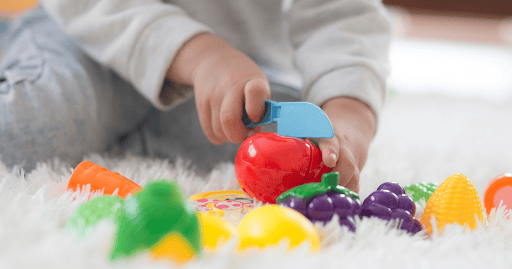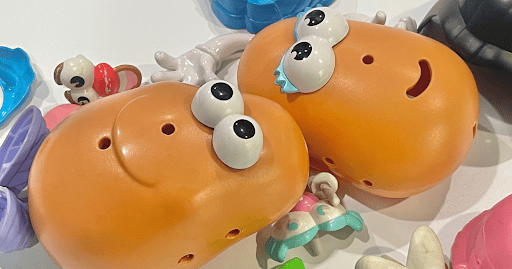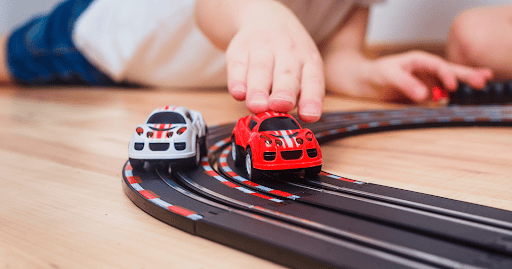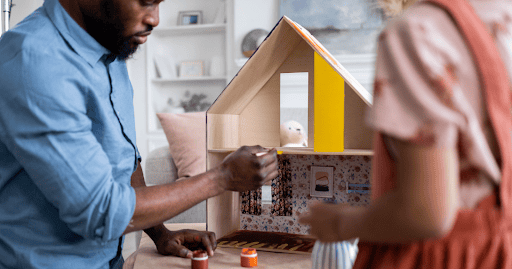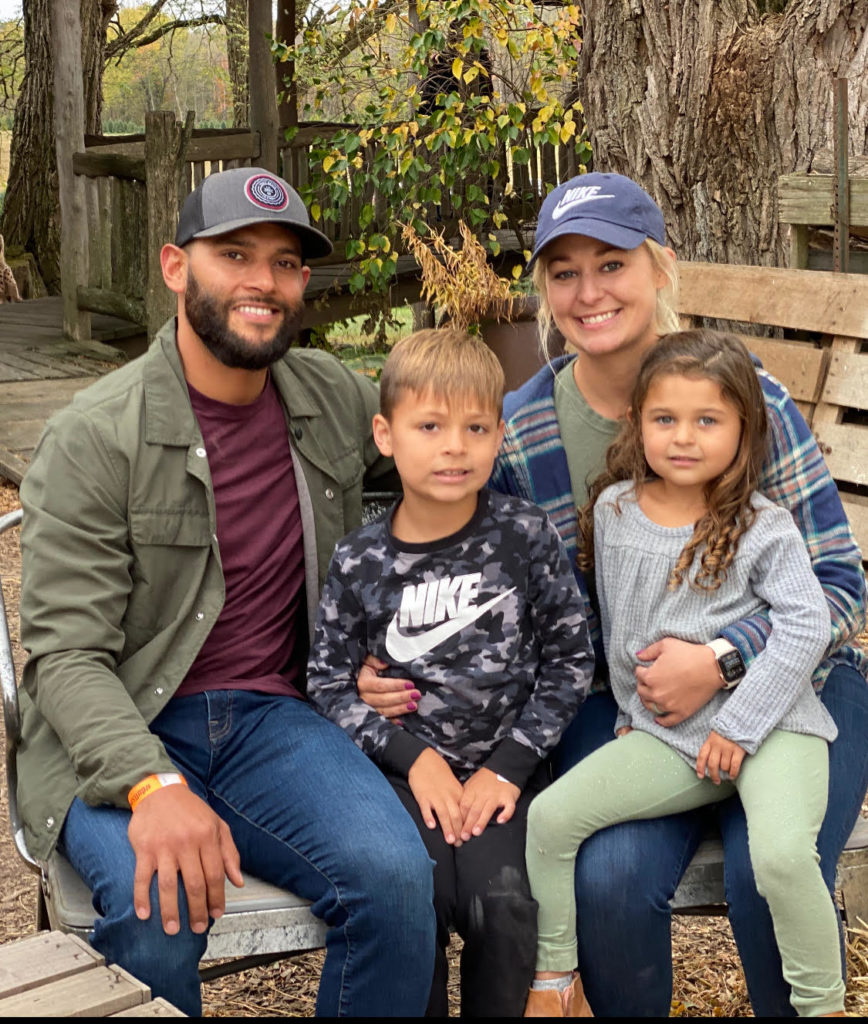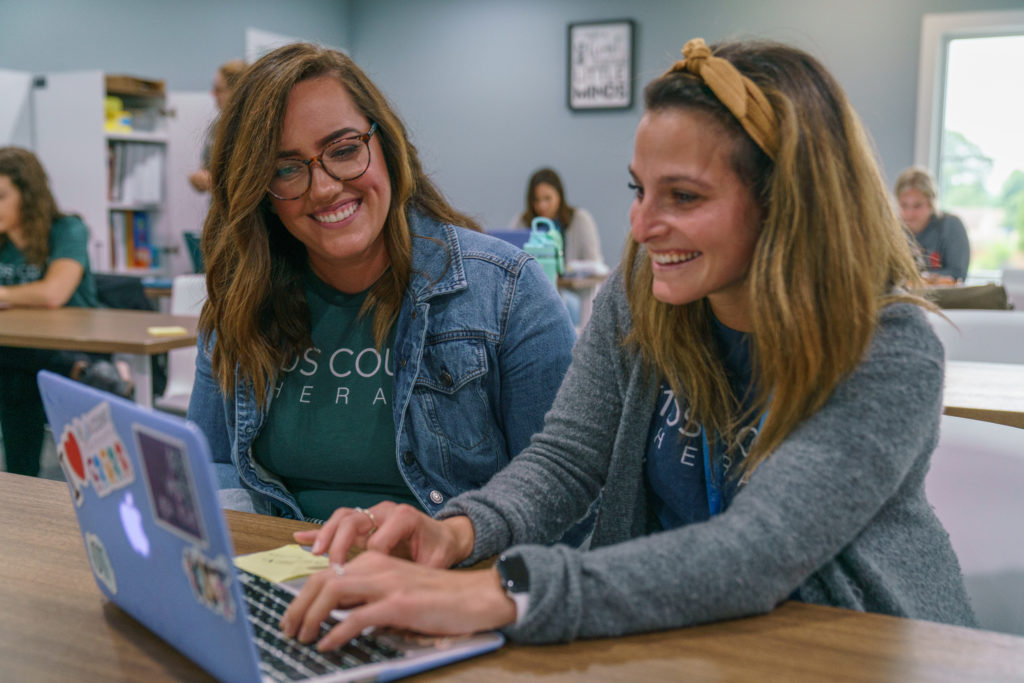Did you know that you can work on early language skills while playing with almost any toy? There’s so much more to play than just playing. Play is how children learn to discover the world, build interests, and strengthen cognitive, motor, social, social-emotional, and language skills. Play is engaging in an activity for enjoyment and recreation and often referred to as one of the main jobs for early learners. Everyday play activities and toys present many opportunities to grow and nurture a child’s language skills. Here are five toys and activities that can be in the home that your child will love and can help develop early language skills!
Velcro Food
Velcro pretend food is perfect for a little chef to play restaurant, kitchen play, and grocery shopping. Velcro pretend food comes in all types of varieties like this plastic play set from Amazon or different wooden play sets from Melissa & Doug. Practice naming foods and colors as you pretend to have a picnic or model short phrases while preparing dinner for a diner customer!
Additional Skills that can be targeted:
- Naming foods: saying ”carrot” while holding up a carrot before pretending to take a bite
- Naming items related to eating: saying “cup” while taking a sip at a tea party
- Teaching verbs (i.e. eat, drink, cut, pour): saying “chop” while cutting the velcro foods
- Identify or sort colors: sorting the red foods versus green foods
- Practice turn-taking: model playing with a toy then giving your child a turn saying “your turn”
- Following simple instructions: try “put the _____ on the plate” or “put the ____ into the sink”
- Learn basic concepts: compare two items and label big & small, in & out, or sweet & sour
- Build noun+verb combination phrases/sentences: pretend to eat a banana and say “Eating banana”
- Ask wh-questions to continue the fun: “What are you eating?”
Potato Head
A Potato Head is a childhood classic and a perfect addition to any child’s toy box. Potato Heads also have many themes and accessories to match your child’s interests or activities. With enough Potato Heads you create the entire family, create a Potato-rockstar, or blast a Potato Head out into space! These little taters are also great. to work on fine motor skills for your tots too!
Additional Skills that can be targeted:
- Naming body parts or clothing: insert an accessory while labeling it
- Discuss the functions of body parts: say “____ help you _____”
- Labeling clothing items prepositions:as you place accessories on, say “The hat is on top”
- Learn basic concepts: compare two items and label big & small, in & out, or short & long
- Following simple directions: try asking your child to “Put the shoes on”
- Requesting items: help your child to ask for “more”, specific colors, or pieces
- Build noun+verb combination phrases/sentences: model and say “Put in arm”
Toy Cars
Rev your engines and race to add cars to the collection. Big or small, we love the all and how they can increase early language skills! Adding a toy car ramp or garage, can add even more opportunities to practice language skills with your child. Using chalk or markers is another easy way to add to the fun or add your child’s favorite community stops.
Additional Skills that can be targeted:
- Practice labeling verbs: pushing the car and saying “go” or saying “stop” when it reaches the end of the track
- Learn basic concepts: model the car going fast, slow,up, down, go, and stop
- Build transportation & community vocabulary: focus on words like drive, stop, house, Hospital, stop sign
- Ask different wh-questions: try “Where is the car going?”
- Build noun+verb combination phrases/sentences: model and say “Train on tracks”,
- Model vocal play sounds like “weee”, “vroom-vroom”, or “wee-woo-wee-woo”
Dollhouse or Barn
Knock, knock! Who’s there?Language development is here, there, and everywhere while using a dollhouse or farmhouse toy set. Use different furniture pieces or add in other toys. Like blue Playdoh to make a pond or pool. This can create additional opportunities for new vocab. Practice imitating animal sounds as they exit the barn doors, or start telling a story and ask questions to have your child continue the fun.
Additional Skills that can be targeted:
- Ask different wh-questions: try “Who is at the door?”, “Where is the _____?”
- Following simple directions: try asking your child to “Hand me ____” or “Put ___ in the bed”
- Introduce new vocabulary terms: sink, pond, barn, gate, window
- Use prepositions while labeling: “The duck is in the pond” or ‘’The duck is flying high”
- Build noun+verb combination phrases/sentences: model and say “___ is in the kitchen”
- Model vocal play sounds like “moooo”, “shhhhh”, “knock, knock, knock”
Blocks
Build skills while building blocks! There are no limits to a little engineer’s imagination. Building blocks can be used to follow simple instructions like ‘put on’, ‘put in’ ‘push’, or ‘hand me a block’. Labeling colors, sizes, or pictures on the blocks can also be a great way to build vocabulary and expand utterances. Following your child’s lead, finding. opportunities to model language, and making the activity full of fun can help to create a safe and nurturing environment for your child to play and learn!
Additional Skills that can be targeted:
- Naming colors or objects on blocks: saying ”red block” while stacking it on top
- Following simple instructions: try “put the block in” or “hand me green block”
- Label prepositions while stacking: “The big block is under”
- Practice identifying shapes: build the blocks into different shapes and label them
- Build noun+verb combination phrases/sentences: as you build “yellow block on top” or “Oops,they fell down!”
- Identify or sort colors: sorting the red blocks versus green blocks
- Learn basic concepts: compare two items and label big & small or tall & short
Playtime is a wonderful opportunity for children to explore, learn, and grow. It’s not about having the latest or most expensive toys, but rather about engaging with your child and providing them with the language they need to develop their skills. By participating in their play, you are not only creating cherished memories but also fostering their early language growth.So, let your imagination run wild, get down on the floor, and join in the fun! Happy playtime and language learning!


